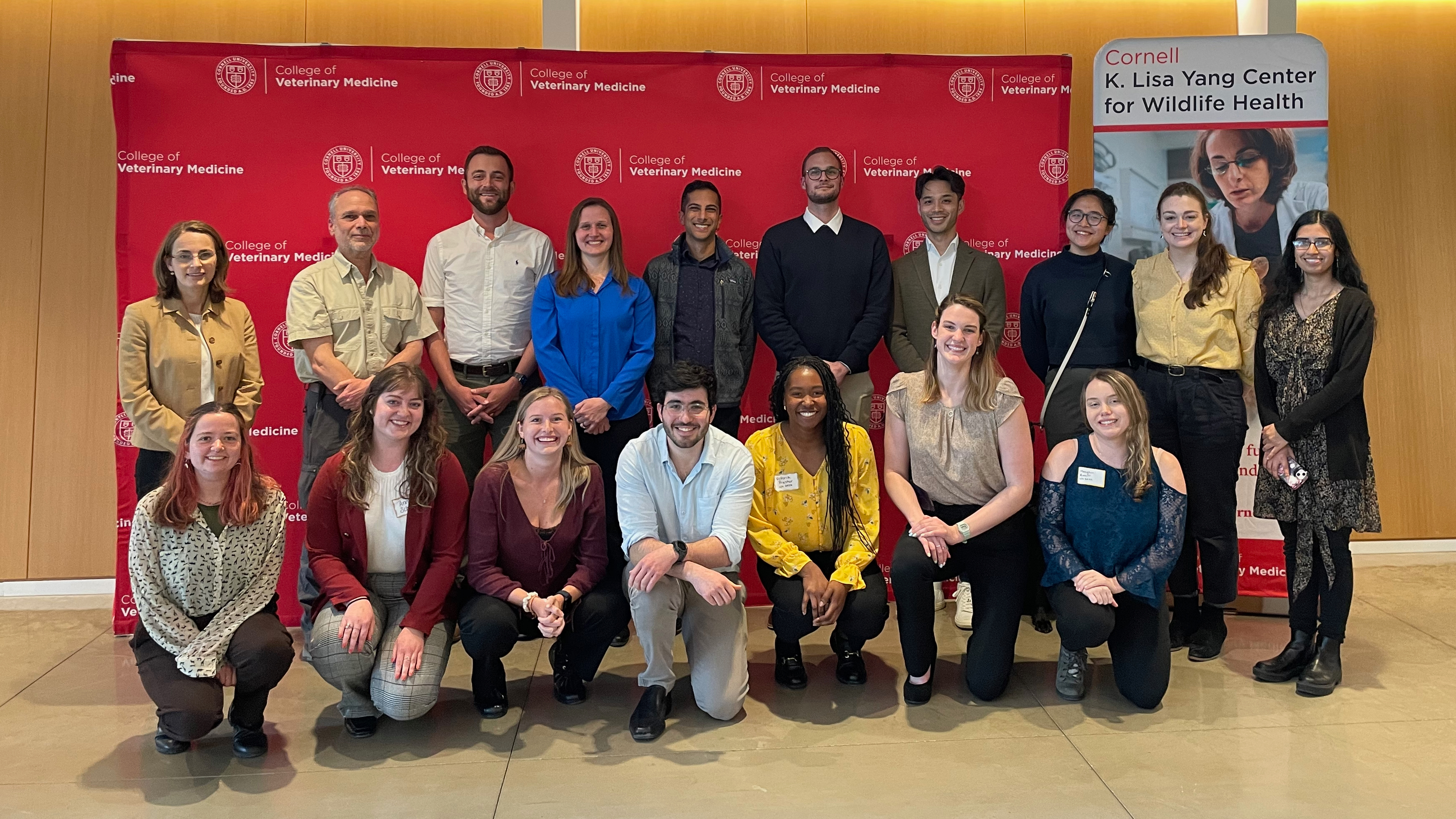Wildlife Conservation Day at the Cornell University College of Veterinary Medicine
On Saturday, April 13, the student-led Zoo and Wildlife Society at the Cornell University College of Veterinary Medicine (CVM) hosted their second annual Wildlife Conservation Day. The day began with a message from keynote speaker Dr. Marc Valitutto, whose career in wildlife conservation has taken him around the world.
Dr. Valitutto described working within the cultural practices of a region to accomplish One Health goals, such as identifying new coronaviruses in Myanmar. He and his team needed to enter bat caves to collect samples from bats to analyze them for novel viruses, but because the caves have cultural and religious significance, wearing shoes inside the caves was forbidden. Recognizing the potential for disease transmission without wearing protective clothing, Dr. Valitutto and his team spent six months working with religious leaders to gain permission to wear shoes inside the caves. This became a recurring theme throughout the Wildlife Conservation Day: respectfully integrating oneself into the cultural practices of a place where a researcher is hoping to have an impact on conservation and One Health.
Attendees also heard from CVM’s Dr. Sara Childs-Sanford and Dr. Cynthia Hopf-Dennis, both diplomates of the American College of Zoological Medicine (ACZM), who demonstrated how a strong clinical background in wildlife medicine translates into the provision of high quality care to patients that come to the Janet L. Swanson Wildlife Hospital at Cornell.
In multiple instances, they have been able to work with other specialists at Cornell to identify viruses in new hosts and new presentations of parasitic infections in wildlife species. They also highlighted the importance wildlife rehabilitators and members of the public can have in identifying wildlife health concerns. Work with volunteers of the Braddock Bay Raptor Research Center banding team, for example, led to the identification of cases of oral capillariasis in sharp-shinned hawks.
Recent Cornell alumni working in wildlife medicine also returned to present on their wildlife health and policy work in other parts of North America. Ben Jakobek, DVM ’20, described a unique group of beluga whales living in the St. Lawrence Estuary of Quebec. He discussed the issue of toxoplasmosis infections in beluga whales, and how he and his research collaborators are directing their efforts to identify how the whales get infected.
J. Hunter Reed, DVM ‘20, discussed disease transmission concerns between aoudads, an exotic mountain sheep species that was initially introduced to the US for hunting purposes, and native desert bighorn sheep in Texas. He also noted the difficulty of finding a single solution when most land in Texas is privately owned. Wild sheep hunting activities can be profitable both for private landowners and for Texas Parks and Wildlife, who can then direct profits made from hunting into conservation initiatives. Careers in wildlife conservation can often involve a delicate balance involving disease surveillance, work to improve policy, and the generation of funding for conservation initiatives.
“Seeing speakers come full circle from attendees when they were in vet school to speaking about their research as veterinarians in the field was really fulfilling,” said Anna Schultz, DVM ’26, and the ZAWS Chair of Wildlife Conservation Day. “I was trying to pick speakers to get variety in the content presented, but the cool thing was that most of the speakers were already friends or knew each other.”
Dr. Izzy Hirji is one example. He attended the Special Species Symposium (an annual event alternately hosted by CVM and the University of Pennsylvania School of Veterinary Medicine) as a veterinary student, and his career has now taken him across Africa in search of the source of a novel pathogen, Sarcina troglodytae, which causes neurologic disease in chimpanzees. Dr. Hirji lectured on the initial detection of clinical signs in chimpanzees at Tacugama Chimpanzee Sanctuary and ongoing collaboration with PhD students and veterinarians in Sierra Leone, Uganda, among other places, to determine the bacterium’s prevalence and distribution in the environment and how to prevent fatal infections.
The event also showcased multiple ways that Cornell veterinary students interested in wildlife can gain valuable clinical experiences prior to graduation. Veterinary student Lynna Li presented on her time working in Costa Rica as part of Cornell’s Expanding Horizons program, and ZAWS executive board members Kate Alexy, Katelyn Cadwallader and Rimsha Malik presented on cases they assisted with during CVM’s annual trip to the Belize Zoo this past January.
The event concluded with a dinner talk by Steve Osofsky, DVM ’89, the Jay Hyman Professor of Wildlife Health and Health Policy at CVM. Dr. Osofsky had also given a talk at the dinner for the Special Species Symposium in 1999, almost 25 years ago to the day. He concluded Wildlife Conservation Day with an entertaining set of anecdotes and ‘O-tips’ from his own career, encouraging students to gain a strong clinical background, invest time in networking, and to be creative in searching for and even developing their own job opportunities when the path to where they want to go is not necessarily well-trodden.
“People always say the wildlife conservation field is so competitive, but today made it clear that the field is also really collaborative,” Schultz reflected. “Everyone wants to share knowledge and information because the work we’re trying to accomplish is so important. You really can’t do anything in the wildlife field alone, because we need each other and can’t know everything about every species.”
Written by Victoria Priester, Cornell DVM ‘26

